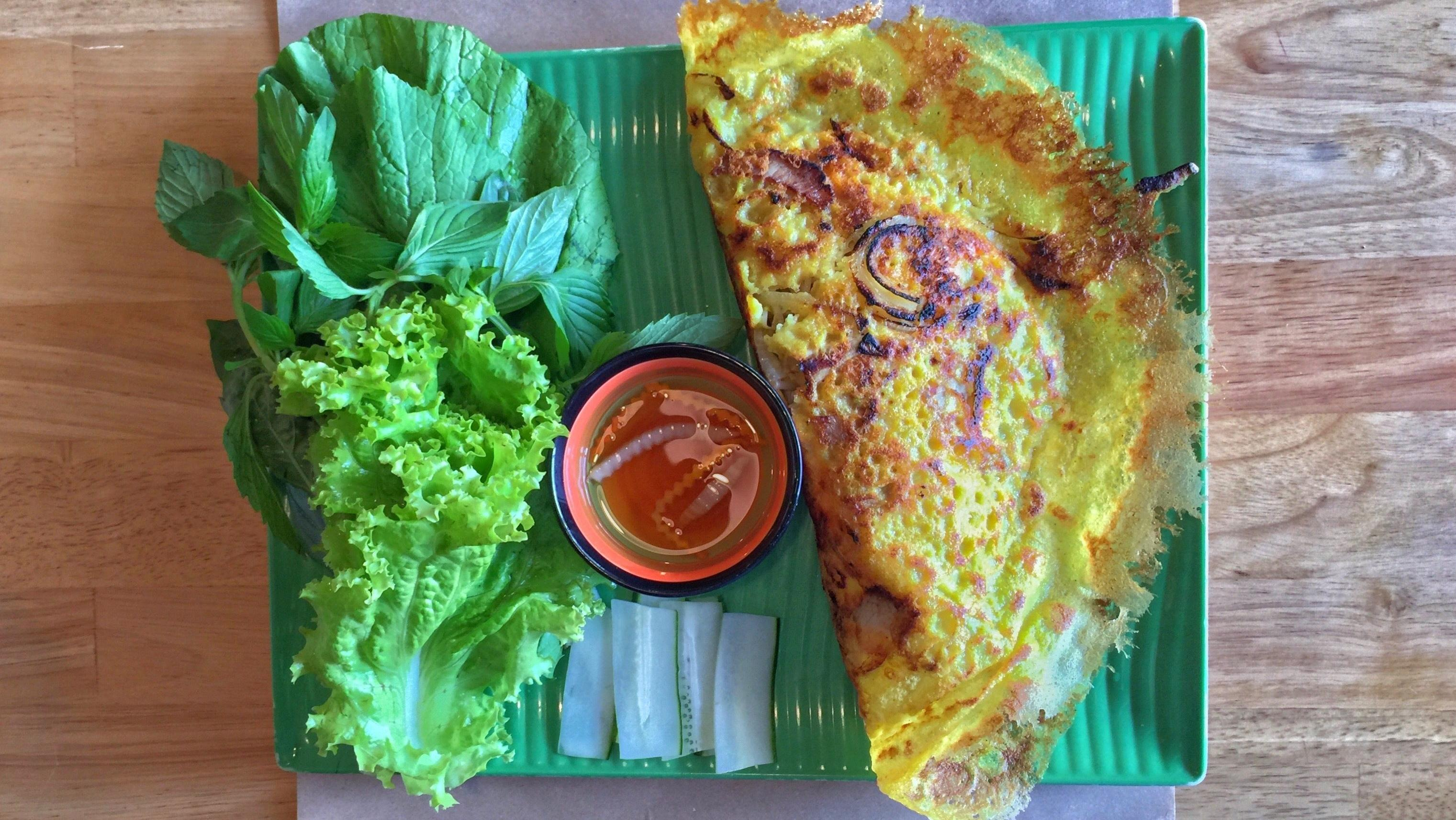The Many Varieties Of Banh Xeo, The Vietnamese Sizzling Crepe
There's more than one way to enjoy this savory, crunchy treat.
One of my favorite memories as a child was watching my mom and my aunts huddle around the kitchen, making banh xeo. These sizzling crepes, as they are called, involved a careful concoction of rice flour, turmeric powder, water, and coconut cream. I often stood to the side while the women poured the light, thin batter into a hot frying pan, mesmerized by the sizzling sound it made while it cooked.
Between short conversations and quips against one another's husbands, they watched the crepes with eagle eyes. Make the batter too thin and it will fall apart in the pan; make them too thick and it will turn into something else. When the crepes cooked to a certain texture, they folded in the fillings, usually a combination of pork slices and bean sprouts. The result resembled to a taco, a savory and crunchy delight. To eat banh xeo, we wrapped it in green leaf lettuce or a variety of herbs and vegetables and dipped it in fish sauce.
In Vietnamese culture, banh xeo is known by several names—sizzling crepe, Vietnamese pancake, or a close relative of Japanese Okonomiyaki and Korean Jeon. To cook banh xeo involves incredible precision in terms of batter and temperature that it would take more than a few attempts before one can get it just right. But while the Vietnamese can agree as to how it should taste and how it should be cooked, many are uncertain as to how it originated in the first place.
What is banh xeo?
There are multiple theories as to how banh xeo became an important key dish in Vietnamese cuisine. Some say that it originated with the Champa people who once ruled Central Vietnam, while others say it originated during the Tay Son era. Many claims that it did not come into popularity until the mid-80s, when hordes of Vietnamese people came down to the south. Then there are those who believe that it came from Hue, a city in central Vietnam.
No matter its true origin, one thing that Vietnamese people can agree on is that it is an emblem of many differences, taken and adapted from a basic recipe into something much more fulfilling and unique to their region.
To balance out the flavor and add to the crunch, many Vietnamese people often wrap banh xeo in a bed of leafy green lettuces or a combination of lettuce, cilantro, and more bean sprouts, dipped fortuitously in a special fish sauce made with the addition of chilis, lime juice, water, and sugar.
The many delicious varieties of banh xeo
Banh xeo can be found at food stalls in the city or cooked at home on special occasions, but what makes it so unique is the varieties of fillings it can have. While southern banh xeo (known as banh xeo mien tay) is often very large, the batter made with a generous amount of coconut milk or cream, people in other parts of Vietnam have made slight adaptations to the way it is prepared and enjoyed.
In Quy Nhon, a coastal city in central Vietnam, banh xeo is normally made with hand-ground rice flour and serve open faced rather than folded in. Nearby in Quang Ngai, the capital city of Quang Ngai province and Quang Nam, people add scallions and eggs and wrap it in rice paper. The result is a crepe that's fluffier and more texturally defined as an omelet.
But the differences do not stop there. Along the south-central coast of Vietnam, such as Khanh Hoa, Ninh Tuan and Binh Thuan provinces, portion sizes are typically smaller, sometimes wrapped in rice paper or not wrapped at all. As for fillings, people use seafood (such as shrimp) instead of pork belly and bean sprouts. Other fillings can include lean slices of beef, onions and mung beans. While a standard batter will include rice flour, some argue that it can also be made with tapioca powder, wheat flour or corn starch. As for size, the more south you go, the bigger the banh xeo.
These days, banh xeo is so common that you can find it at almost every Vietnamese pho restaurant in town. However, it's not often highlighted the same way as pho would be; oftentimes, the dish is tucked underneath other sections titled "Specialties" or "Vermicelli," as it does at my favorite local restaurant. Eat one of these sizzling crepes and you'll be surprised just how full you'll feel afterwards. The light fragrance of coconut and its beautiful golden hue (thanks to the turmeric) followed by the sizzle and steam and the crunch in your mouth is no doubt one of the most delightful experiences around.
